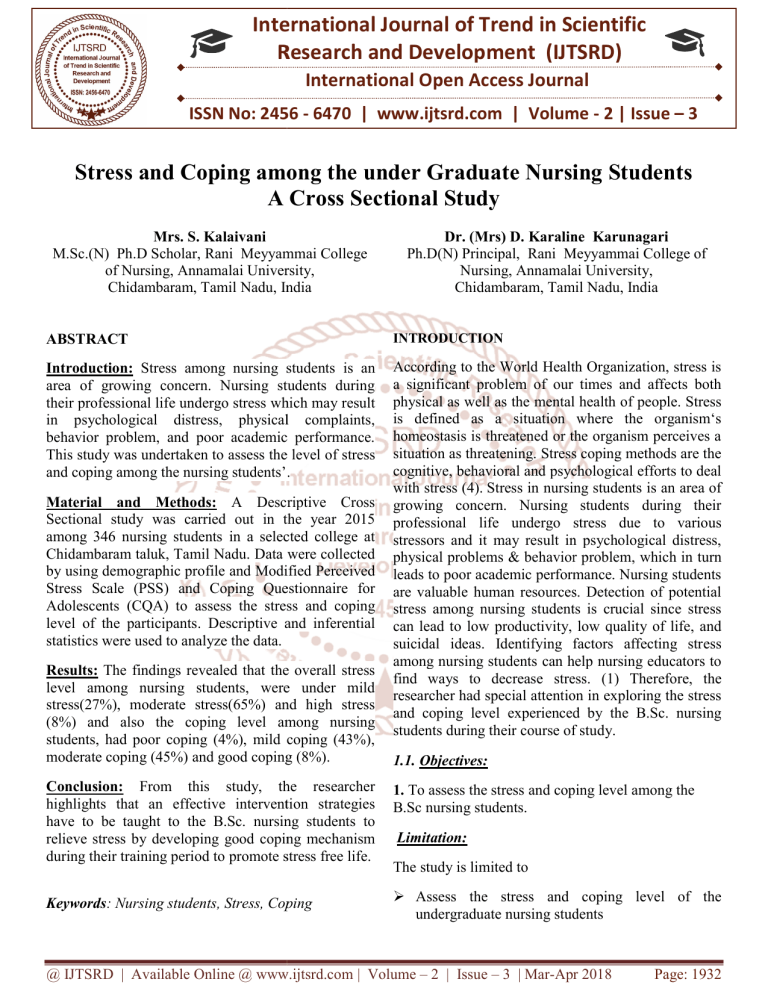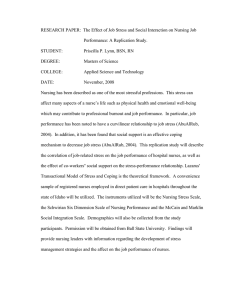
International Journal of Trend in Scientific
Research and Development (IJTSRD)
International Open Access Journal
ISSN No: 2456 - 6470 | www.ijtsrd.com | Volume - 2 | Issue – 3
Stress and Coping among the under
nder Graduate Nursing Students
A Cross Sectional Study
Mrs. S. Kalaivani
M.Sc.(N) Ph.D Scholar, Rani Meyyammai College
of Nursing, Annamalai University,
Chidambaram, Tamil Nadu, India
Dr. (Mrs) D. Karaline Karunagari
Ph.D(N) Principal, Rani Meyyammai College of
Nursing, Annamalai University,
Chidambaram,, Tamil Nadu,
Nadu India
ABSTRACT
INTRODUCTION
Introduction: Stress among nursing students is an
area of growing concern. Nursing students during
their professional life undergo stress which may result
in psychological distress, physical complaints,
behavior problem, and poor academic performance.
This study was undertaken to assess the level of stress
and coping among the nursing students’..
According to the World Health Organization, stress is
a significant problem of our times and affects both
physical as well as the mental health of people. Stress
is defined as a situation where the organism‘s
homeostasis is threatened or the organism perceives a
situation as threatening. Stress coping methods are the
cognitive, behavioral and psychological efforts to deal
with stress (4). Stress in nursing students is an area of
growing concern. Nursing students during their
professional life undergo stress due to various
stressors and it may result in psychological distress,
physical problems & behavior problem, which in turn
leads to poor academic performance. Nursing students
are valuable human resources. Detection of potential
stress among nursing students is crucial since stress
can lead to low productivity, low quality of life, and
suicidal ideas. Identifying factors affecting stress
str
among nursing students can help nursing educators to
find ways to decrease stress. (1) Therefore, the
researcher had special attention in exploring the stress
and coping level experienced by the B.Sc. nursing
students during their course of study.
Material and Methods: A Descriptive Cross
Sectional study was carried out in the year 2015
among 346 nursing students in a selected college at
Chidambaram taluk, Tamil Nadu. Data were collected
by using demographic profile and Modified Perceived
Stress Scale (PSS) and Coping Questionnaire for
Adolescents (CQA) to assess
sess the stress and coping
level of the participants. Descriptive
escriptive and inferential
statistics were used to analyze the data.
Results: The findings revealed that the overall stress
level among nursing students, were under mild
stress(27%), moderate stress(65%) and high stress
(8%) and also the coping level among nursing
students,, had poor coping (4%), mild coping (43%),
moderate coping (45%) and good coping (8%)
(8%).
1.1. Objectives:
Conclusion: From
rom this study, the researcher
highlights that an effective intervention strategies
have to be taught to the B.Sc. nursing students to
relieve stress by developing good coping mechanism
during their training period to promote stress free life.
1. To assess the stress and coping level among the
B.Sc nursing students.
Keywords: Nursing students, Stress, Coping
Assess the stress and coping level of the
undergraduate nursing students
Limitation:
The study is limited to
@ IJTSRD | Available Online @ www.ijtsrd.com | Volume – 2 | Issue – 3 | Mar-Apr
Apr 2018
Page: 1932
International Journal of Trend in Scientific Research and Development (IJTSRD) ISSN: 2456-6470
Only those who were present during the time of
data collection were included for the study.
Methods:
Design and Sampling:
A quantitative approach with descriptive crosssectional study was conducted during the year 2015.
By using convenient sampling technique, 346 under
graduate students’ nurses from four years were
selected as samples from the selected college at
Chidambaram taluk, Cuddalore district, Tamil Nadu.
The samples who were not willing as well as who
availed leave during the time of data collection were
excluded from the study.
Instruments:
The demographic data were collected using a selfadministered questionnaire.
(Section A),
Modified Perceived Stress Scale (PSS) (Section B)
developed by Sheu et al.,(2002) to assess the stress
level of the subject was used. It is a five-point likert
scale that consisted of 29 items .Each item was scored
on a scale of 0(never), 1(almost never), 2(sometimes),
3(fairly often) and 4(very often).
Level
of
Stress
High
Stress
Moderate
Stress
Mild Stress
Mean
Scores
2.67- 4.00
Score
%
88-116
76-100
1.34- 2.66
59-87
51-75
0 -1.33
0-58
01-50
The scaling was used as follows by using the mean
score and Coping Questionnaire for Adolescents
(CQA) (Section C) was developed by Schweitzer et al
(1995). It consisted of 32- items self- report
questionnaire with 4-point likert scale, designed to
assess the thinking and means used by the subjects to
cope with stressful situations. The rating scale was
scored as 0- I did not use, 1- I used this some of the
time, 2- I used this quite a bit of the time and 3- I used
this almost all of the time. The following scaling was
used
Level of Coping
Poor Coping
Mild Coping
Moderate Coping
Stay Happy &
Good Coping
Percentage
01-25%
26-50%
51-75%
76-100
Data collection and Analysis:
The study was conducted after obtaining approval
from the Institutional Human Ethical Clearance. After
seeking permission from the authority, written
informed consent was obtained from all the
participants before the data collection. The self
administered questionnaire was distributed to all the
samples without disturbing their class schedule for
10-15 minutes and then collected. Confidentiality was
ensured.
Descriptive statistics were used to describe the
demographic variables and to assess the stress and
coping level of the nursing students. The inferential
statistics like mean and standard deviation, ANOVA
and LSD post HOC test were used to investigate the
association between stress and coping level with
demographic variables. The probability value p<0.05
was considered statistically significant.
Results:
The study revealed that, the majority of the subjects
were 27% in the age group of 18- 18.9 years, 27%
were in 4th year, 59.8% were living in the hostel,
46.5% were born as 1st child, 68.8% had own choice
in selection of course, 44% with less than Rs.5000 as
family monthly income, 52.6% of subjects spent 3-5
hours for studying/ day, 39% of subjects had more
than 8 hours sleep/day.
Table 1: Overall Stress Level of the Under
Graduate Nursing Students
N: 346
S.No
1.
2.
3.
Level of Stress
Mild Stress
Moderate Stress
High Stress
N
92
225
29
%
27
65
8
Table 1: depicts the overall level of stress of the
under graduate nursing students, Out of 346 subjects,
65% had moderate stress, 27% had mild stress and
only 8% were highly stressed
Score
<24
25-48
49-72
73-96
@ IJTSRD | Available Online @ www.ijtsrd.com | Volume – 2 | Issue – 3 | Mar-Apr 2018
Page: 1933
International Journal of Trend in Scientific Research and Development (IJTSRD) ISSN: 2456-6470
2456
Table 2: Coping Level of the Under Graduate
Nursing Students
S.No
Level of Coping
N
%
1.
Poor coping
15
4
2.
Mild coping
149
43
3.
Moderate coping
154
45
4.
Good coping and Stay
happy
28
8
Conclusion:
Table 2 depicts the coping level of the under graduate
nursing students. Among 346 subjects, the study
revealed that the coping level among the subjects
were 154(45%) had moderate level of coping,
149(43%) had mild level of coping, 28(8%) had good
level of coping and stay happy and 15(4%) had poor
level of coping.
Coping Level
Fig. 1. Coping Level of the Undergraduate Nursing
Students
200
149
154
150
100
50
0
15 4
43
45
The table 2 showed that out of 346 subjects, 45% had
moderate level of coping, 43% had mild level of
coping,, 8% had good level of coping and stay happy,
and 4% had poor level of coping..The
coping.
present study
results correlated with the findings of Khater WA
et.al., (2014)) revealed that most common coping
behavior utilized by the students was problem solving
among nursing students in Jordan. Further results
showed by Shiferaw HN et.al (2015) quoted that
unhealthy coping strategies (p<0.005) were used by
students irrespective
ve of ethnicity, marital status and
educational levels.
28
8
N
%
Therefore, stress
tress is common among the nursing
students during their course of nursing education. The
researcher highlights that an effective intervention
strategies involving aerobic exercises, yoga,
counseling etc. may be helpful for the nursing
students to overcome
come from their
the stress during their
professional life to make them to be productive and
effective.
“The key is to find an activity that you enjoy and
valuing yourself enough to take the time to engage in
that activity,” said Mariela Gabaroni,
Gabaroni associate
director of Student Health Services. “It is all relative
to the individual, their time management and the
choices they make
ke that can facilitate their learning
process.”(2)
“No one can calm the ocean’s waves, but by stress
management techniques
one can learn to surf the ocean”
References:
Discussion:
In table 1 the present study showed that
that, 65% had
moderate stress, 27% had mild stress and 88% had high
stress among the nursing students which were
consistent with the findings of studies conducted by
Anu Jose M. J. (2016) to assess the level
evel and factors
contributing to stress among the nursing
ursing students. The
results elicited that 68% had moderate stress, 27% had
mild stress and only 5% had severe stress (6). Further
findings quoted by Sharma, N.. & Kaur, A. (2011)
revealed that 97% of the subjects had moderate level
of stress whereas 3% had severe stress (7) which was
also congruent with the findings of the present study.
1) Prasad V.C., Suresh A., Thomas D.K., Pritty MK.,
Beebi S.& Multazim V, (2013).The
(2013).
level of stress
and coping mechanism adopted by I Year B.Sc.
nursing students. Archives of Medicine and health
Sciences, Vol.1 (1):19-23.
2) Shaban I.A., Khater W.A.& Akhu-Zahey
Akhu
L.A.(2012). Undergraduate nursing students’
stress sources and coping behaviours during their
initial period of clinical training: A Jordanian
perspective. Nurse Education in Practice,
Practice Vol.12
(4):204-209.
3) http:www. varvogli@otenet.gr
@ IJTSRD | Available Online @ www.ijtsrd.com | Volume – 2 | Issue – 3 | Mar-Apr
Apr 2018
Page: 1934
International Journal of Trend in Scientific Research and Development (IJTSRD) ISSN: 2456-6470
4) Graham A. (2017). Surveys shows increase in
stress
among
college
students.Florida
International University News
5) Barry S. & Ward L. (2016). Undergraduate
Nursing Students' Understandings of Mental
Health: A Review of the Literature. Journal of
Issues in Mental Health Nursing, Vol.38 (2):160175.
6) Anu Jose M. J. (2015). A Study to assess the level
and factors contributing to stress among the
nursing students.International Journal of Science
and Research (IJSR), Vol. 5(9):1482-1484.
7) Sharma, N. & Kaur, A.(2011). On the factors
associated with stress among nursing students.
Nursing and Midwifery Research Journal, Vol. 7
(1): 12-21.
8) Liu, M., Gu. K., Wong. T.K.S., Luo. M.Z. &Chan.
M.Y. (2015). Perceived stress among Macao
nursing students in the clinical learning
environment. International Journal of Nursing
Sciences, Vol.2(2): 128-13
9) Khater W A., Akhu- Zaheya LM. & Shaban IA.
(2014). Sources of stress and coping behavior in
clinical practice among Baccalaureate nursing
students. International Journal of Humanities and
Social Science, Vol.4(6): 194-202.
10) Shiferaw HN, Anand S and Nemera G .(2015).
Stress and coping strategies among generic B.Sc.
nursing students of Jimma University, South West
Ethiopia. International Journal of Recent
Advances in Multidisciplinary Research, Vol:
2(7): 0511-0517.
@ IJTSRD | Available Online @ www.ijtsrd.com | Volume – 2 | Issue – 3 | Mar-Apr 2018
Page: 1935

